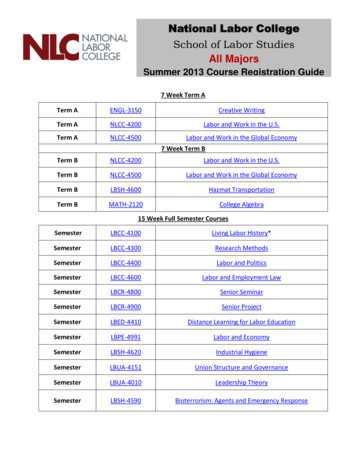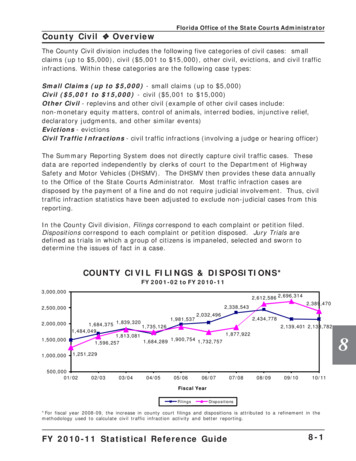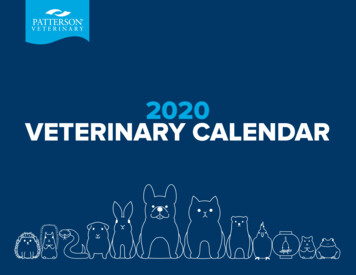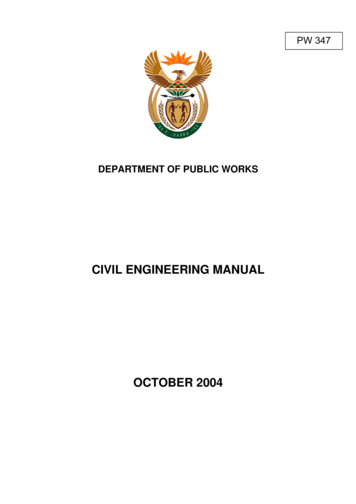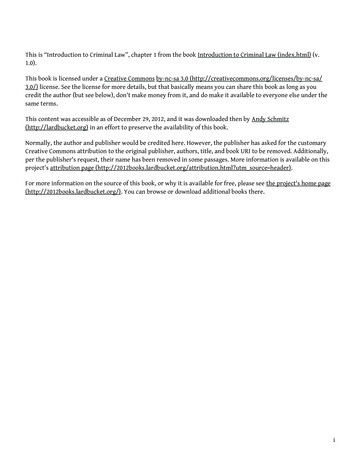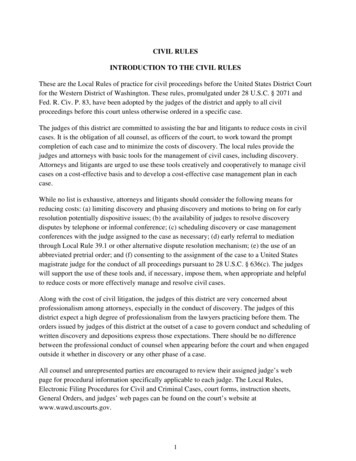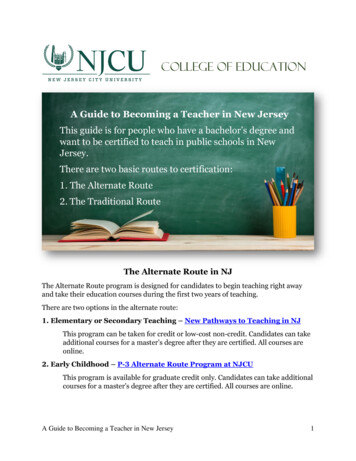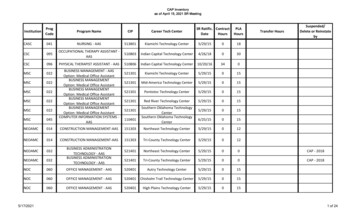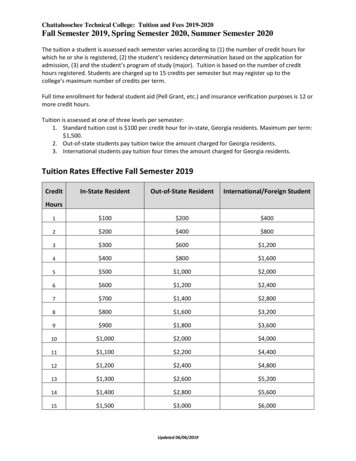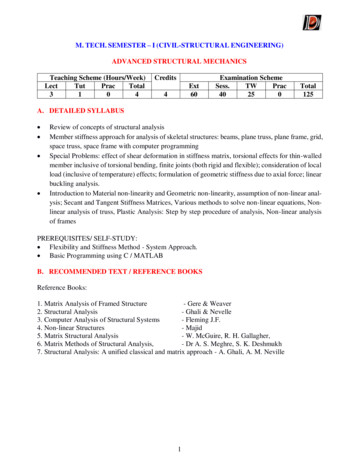
Transcription
M. TECH. SEMESTER – I (CIVIL-STRUCTURAL ENGINEERING)ADVANCED STRUCTURAL MECHANICSTeaching Scheme nation SchemeSess.TWPrac40250Total125A. DETAILED SYLLABUS Review of concepts of structural analysisMember stiffness approach for analysis of skeletal structures: beams, plane truss, plane frame, grid,space truss, space frame with computer programmingSpecial Problems: effect of shear deformation in stiffness matrix, torsional effects for thin-walledmember inclusive of torsional bending, finite joints (both rigid and flexible); consideration of localload (inclusive of temperature) effects; formulation of geometric stiffness due to axial force; linearbuckling analysis.Introduction to Material non-linearity and Geometric non-linearity, assumption of non-linear analysis; Secant and Tangent Stiffness Matrices, Various methods to solve non-linear equations, Nonlinear analysis of truss, Plastic Analysis: Step by step procedure of analysis, Non-linear analysisof framesPREREQUISITES/ SELF-STUDY: Flexibility and Stiffness Method - System Approach. Basic Programming using C / MATLABB. RECOMMENDED TEXT / REFERENCE BOOKSReference Books:1. Matrix Analysis of Framed Structure- Gere & Weaver2. Structural Analysis- Ghali & Nevelle3. Computer Analysis of Structural Systems- Fleming J.F.4. Non-linear Structures- Majid5. Matrix Structural Analysis- W. McGuire, R. H. Gallagher,6. Matrix Methods of Structural Analysis,- Dr A. S. Meghre, S. K. Deshmukh7. Structural Analysis: A unified classical and matrix approach - A. Ghali, A. M. Neville1
M. TECH. SEMESTER – I (CIVIL-STRUCTURAL ENGINEERING)ADVANCED FOUNDATION ENGINEERINGTeaching Scheme nation SchemeSess.TWPrac40250Total125A. DETAILED SYLLABUS Planning of subsoil exploration of major civil engineering projects, deriving characteristic strengthdeformation parameters from soil exploration report, calculation of safe bearing capacity for various soil types from shear as well as settlement criteria, pull out resistance of foundations, extrapolation of plate load test and pile load tests.Proportioning of isolated footings, combined footings, raft, floating foundations for different loadcombinations,Design of pile foundation for axial load – compression and pull out, lateral loads, negative skinfriction, group action in piles, design of piles capFoundations for water tanks, chimney, transmission line towers, antenna etc.Free and fixed cantilever sheet pile walls, anchored bulkheadsPREREQUISITES/ SELF-STUDY: Methods of drilling/boring and sampling.Field Test Procedures as per IS Code: SPT, SCPT, Plate Load Test, Pile Load TestLaboratory Test Procedures as per IS Code: Classification Tests, Shear Tests, Consolidation Test,Swell Tests,Bearing Capacity as per IS 6403 for Shallow Foundations, Settlement Calculations for Sand andClay soils as per IS 8009.B. RECOMMENDED TEXT / REFERENCE BOOKS1.2.3.4.5.6.7.8.Analysis and design of foundation- J. E. BowlesSoil mechanics & foundation engg. vol-II- V.N.S. MurthyPrinciples of foundation Engg.- Braj M. DasFoundation Engineering- M.J. TomlinsonAnalysis and Design of Substructures- Swami SaranFoundation Design – CodutoDesign Aids in Soil Mecahnics and Foundation Engg. - KanirajSP 36, pt 1 and 2, IS 6403, IS 8009 pt.1, IS 2911 (all),2
M. TECH. SEMESTER – I (CIVIL-STRUCTURAL ENGINEERING)SOLID MECHANICS WITH FINITE ELEMENT APPLICATIONSTeaching Scheme nation SchemeSess.TWPrac40250Total125A. DETAILED SYLLABUS Linear elasticity; stress, strain, constitutive relations; Boundary conditions; Description of anelasticity problem as a boundary value problem, Plane stress, strain, axial symmetrical problems. Introduction to plasticity, Yield condition; ideal elasto-plastic material. Analysis of Continuum and discrete structures, finite element principle and solution for continuum problems, steps in finite element analysis, principles of discretization, formulation of element stiffness matrix based on direct, variation principles, shape functions, numerical integration, convergence, 2-D formulations for plane stress, plane strain, axisymmetric including isoperimetric elements, introduction to 3D brick elements for Continuum problems.B. RECOMMENDED TEXT / REFERENCE BOOKS1.2.3.4.5.6.Finite Element AnalysisFinite Element MethodThe Finite Element MethodThe Finite Element MethodConcepts and Application of Finite Element AnalysisAdvance Mechanics of Solids3- Krishnamurthy- Desai & Ables- Rockey, Evans & others- Zienkiewicz- Cook- Srinath
M. TECH. SEMESTER – I (CIVIL-STRUCTURAL ENGINEERING)DESIGN & DETAILING OF STRUCTURAL ELEMENTS: RCCTeaching Scheme nation SchemeSess.TWPrac02525Total90A. DETAILED SYLLABUS Introduction to various design methods i.e. Working Stress Method, Ultimate Load Method andLimit State Method.Design of Singly Reinforced and Double Reinforced Rectangular Beams for Limit State ofCollapse for Flexure. Development of non-linear moment-curvature relationship.Design of Flanged Beams for Limit State of Collapse for FlexureDesign of Rectangular Beams for Limit State of Collapse for Shear and Torsion.Design of One-way and Two-way simply supported and continuous Slabs.Design of Short and Slender Columns subjected to Axial Load and Uniaxial or Biaxial Bending.Development of non-linear P-M-M relationship.Design of Isolated and Combined FootingsPreparation and use of excel sheets for RCC element designB. RECOMMENDED TEXT / REFERENCE BOOKS1.2.3.4.5.Design of RCC Structures Vol-IReinforced Concrete DesignDesign of RCC StructuresReinforced Concrete DesignReinforced Concrete Design- H. J. Shah- N. Krishna Raju- P. C. Varghese- S. N. Sinha- S Unnikrishna Pillai & Devdas Menon4
M. TECH. SEMESTER – I (CIVIL-STRUCTURAL ENGINEERING)DESIGN & DETAILING OF STRUCTURAL ELEMENTS: STEELTeaching Scheme nation SchemeSess.TWPrac02525Total90A. DETAILED SYLLABUS Introduction to various design methods i.e. Working Stress Method, Ultimate Load Method andLimit State Method - Brief History and Comparison.Design of Tension Members made up of single and built-up sections, Choice of sections, Connections (riveted, bolted & welded), Splices.Design of Compression Members: Single and Built-up sections, Choice of sections, lacing andbattering.Design of Laterally Restrained and Unrestrained Beams including deflection check.Design of Slab base, Gusseted base.Design of members subjected to combined actions, bending with compression/tension.Preparation and use of excel sheets for RCC element designB. RECOMMENDED TEXT / REFERENCE BOOKS1.2.3.4.5.Design of Steel StructuresDesign of Steel StructuresDesign of Steel StructuresDesign of Steel Structures – Vol 1 and Vol. 2Design of steel Structures- N. Subramanian- Arya & Ajmani- S. Ramamrutham- Ramchandran- P. Dayaratnam5
M. TECH. SEMESTER – I (CIVIL-STRUCTURAL ENGINEERING)ELECTIVE PAPER – ITeaching Scheme nation SchemeSess.TWPrac0250Total651. THEORY OF THIN PLATES AND SHELLSA. DETAILED SYLLABUSThin plate: small deflection theory, plate equation. Applications of Navier’s solution, Levy’s solution,tables & charts for solution of rectangular and circular plates, use for rectangular water tanks withdifferent boundary conditions.Shell behaviour, shell surfaces and characteristics, classification of shells equilibrium equations incurvilinear co-ordinates. Stress-strain & force displacement relations. Membrane analysis of shells ofrevolution and cylindrical shells under different loads.Applications of membrane solution of elliptic paraboloids and hyperboloids. Solution of some typicalproblems.B. RECOMMENDED TEXT / REFERENCE BOOKS1. Theory of Plates and shells- S.P.Timoshenko and Woinowsky-Krieger2. Design of cylindrical shell roofs- W.T. Marshall3. Design & construction of concrete shell roofs- Ramaswamy, G. S.4 A Text Book of Plate Analysis- Bairagi N. K.5. Shell Analysis- Bairagi N.K.6. Theory and Analysis of Plates : Classical and Numerical Methods - Szilard R.-------------------------------- ------ -------------------------------2. THEORY OF STRUCTURAL STABILITYA. DETAILED SYLLABUS Criteria for Design of Structures: Stability, Strength, and Stiffness, Classical Concept ofStability of Discrete and Continuous Systems, Linear and nonlinear behaviour.Stability of Columns: Axial and Flexural Buckling, Lateral Bracing of Columns, CombinedAxial, Flexural and Torsion Buckling.Stability of Frames: Member Buckling versus Global Buckling, Slenderness Ratio of framemembers.Stability of Beams: Lateral torsional buckling.Stability of Plates: Axial flexural buckling, Shear flexural buckling, buckling under combinedloads.Introduction to Inelastic Buckling and Dynamic Stability.6
B. RECOMMENDED TEXT / REFERENCE BOOKS1. Theory of elastic stability- Timoshenko and Gere,2. Principles of Structural Stability Theory - Alexander Chajes3. Structural Stability of columns and plates - Iyengar, N. G. R.4 Strength of Metal Structures- Bleich F. Bucking-------------------------------- ------ -------------------------------3. ADVANCED CONCRETE TECHNOLOGYA. DETAILED SYLLABUSCement: Hydration, chemistry and microstructure of cement paste, special cementMicrostructures of concrete: Interfacial transition zone, Structure-property relationships.Chemical and mineral admixtures in concrete: Types, Mechanism, Application.Properties of hardened concrete:Strength, stress-strain behavior, Dimensional stability, Fracture mechanics and concrete failure mechanism.Mix Design: Concrete mix design (IS, ACI, BS)Concrete Durability:Physical deterioration (abrasion, erosion, cracking) Chemical attack (sulfates/seawater/acid), Corrosion, Durability improvement measures.Testing and quality assurance of concrete: Testing of fresh concrete, Destructive and non-destructive evaluation of hardened concrete, statistical quality control.Special concrete: Cement and polymer concrete compositions, Self-compacting concrete, Readymixed concrete, High performance concrete.B. RECOMMENDED TEXT / REFERENCE BOOKS1. Concrete technology2. Micro Concrete- A. N. Nevile, J.J. Brooks- P. Kumar Mehta-------------------------------- ------ --------------------------------7
M. TECH. SEMESTER – I (CIVIL- STRUCTURAL ENGINEERING)SUBJECT: AUDIT COURSE – I: DISASTER MANAGEMENTTeaching Scheme ation SchemeSess.TWPrac000Total0A. DETAILED SYLLABUS1.IntroductionDisaster: Definition, Factors and Significance; Difference between Hazard and Disaster; andMagnitude.2.Repercussions of Disasters and Hazards: Economic Damage, Loss of Human and Animal Life,Destruction of Ecosystem. Natural Disasters: Earthquakes, Volcanisms, Cyclones, Tsunamis,Floods, Droughts And Famines, Landslides And Avalanches, Man-made disaster: NuclearReactor Meltdown, Industrial Accidents, Oil Slicks And Spills, Outbreaks Of Disease AndEpidemics, War And Conflicts.3.Disaster Prone Areas In IndiaStudy of Seismic Zones; Areas Prone To Floods and Droughts, Landslides and Avalanches;Areas Prone To Cyclonic and Coastal Hazards with Special Reference to Tsunami; Post-DisasterDiseases and Epidemics4.Disaster Preparedness And ManagementPreparedness: Monitoring Of Phenomena Triggering A Disaster Or Hazard; Evaluation Of Risk:Application Of Remote Sensing, Data From Meteorological And Other Agencies, Media Reports:Governmental And Community Preparedness.5.Risk AssessmentDisaster Risk: Concept and Elements, Disaster Risk Reduction, Global and National DisasterRisk Situation. Techniques of Risk Assessment, Global Co-Operation in Risk Assessment andWarning, People’s Participation in Risk Assessment. Strategies for Survival.6.Disaster MitigationMeaning, Concept and Strategies of Disaster Mitigation, Emerging Trends in Mitigation.Structural Mitigation and Non-Structural Mitigation, Programs Of Disaster Mitigation in India.B. RECOMMENDED TEXT / REFERENCE BOOKS1.2.3.Disaster Management in India: Perspectives, issues and strategies - R. Nishith, Singh AKDisaster Mitigation Experiences and Reflections- Sahni, PardeepEt.Al.Disaster Administration and Management Text and Case Studies - Goel S. L.8
M. TECH. SEMESTER – II (CIVIL-STRUCTURAL ENGINEERING)DYNAMICS AND EARTHQUAKE ENGINEERINGTeaching Scheme nation SchemeSess.TWPrac40250Total125A. DETAILED SYLLABUS SDOF Systems: Equation of motion, free vibration, harmonic load, evaluation of damping, periodic load, general load (time-domain, frequency domain) response spectrum load.MDOF systems: Structural matrices, undamped free vibrations; generation of damping matrix;mode superposition analysis; practical considerations.Characterization of ground motion; earthquake intensity and magnitude; recording instrumentsand baseline correction; predominant period and amplification through soil; Earthquake spectrafor elastic and in-elastic systems, idealization of structural systems for low, medium and highrise building; effect of foundation/soil on earthquake response; Codal provisions.B. RECOMMENDED TEXT / REFERENCE BOOKS1. Dynamics of Structures2. Dynamics and Vibration of Structures3. Introduction to Structural Dynamics4. Structural Vibrations - Theory and5. Structural Dynamics6. Elements of earthquake engineering- Anil K. Chopra- Demeter G.Fertis- John M.Biggs- Mario Paz Computation- Clough & Penzien- Jaikrishna & Chandrasekaran9
M. TECH. SEMESTER – II (CIVIL-STRUCTURAL ENGINEERING)SOIL STRUCTURE INTERATIONTeaching Scheme (Hours/Week)LectTutPracTotal3104CreditsExamination SchemeSess.TWPrac40250Ext604Total125A. DETAILED SYLLABUS Critical study of conventional methods of foundation design; Nature of complexities of soilstructure interaction; Application of advanced techniques of analysis such as the finite elementmethod, finite differences, relaxation and interaction for the evaluation of soil-structure interaction for different types of structures under various conditions of loading and subsoil characteristics;Preparation of comprehensive design-oriented computer programs for specific problems.Interaction problems based on the theory of sub-grade reaction such as beams, footings, raftsbulkheads etc, Analysis of different types of framed structures founded on stratified naturaldeposits with linear and non-linear stress-strain characteristics.Determination of axial and lateral pile capacities; group action of piles considering stress-straincharacteristics of real soils.B. RECOMMENDED TEXT / REFERENCE BOOKS1234Analysis and design of foundationNumerical Methods in Geotechnical Engg.Elastic Analysis of Soil Foundation InteractionAdvanced Geotechnical Engineering10- J. Bowles- Desai & Christian- A P S Selvadurai- C S Desai, M. Zaman
M. TECH. SEMESTER – II (CIVIL-STRUCTURAL ENGINEERING)ELECTIVE PAPER – IITeaching Scheme nation SchemeSess.TWPrac40250Total1251. PRESTRESSED CONCRETEA. DETAILED SYLLABUSPrestressing concepts, materials, systems of prestressing and losses. Introduction to working stressmethod, limit state analysis and design of members for bending. Shear torsion and forces. End blockdesign. Deflections, use of relevant codes of practice.B. RECOMMENDED TEXT / REFERENCE BOOKS1. Design of Prestressed Concrete Structures – Krishna Raju2. Limit State Design of Prestressed Concrete Structures – Mallick & Gupta-------------------------------- ------ -------------------------------2. BRIDGE ENGINEERINGA. DETAILED SYLLABUS Loading Standards.Design of Balanced Cantilever Bridge.Design of Bow String Girder Bridge.Design of prestressed concrete girder and box girder bridges considering only primary torsion. Design of end block.Bridge Bearing: Types of Bearings, Elastomeric bearing.Piers, Abutments, Wing walls factors effecting and stability. Well foundations. Design ofwell, Construction, open sinking of walls, Plugging, sand filling and casting of well cap.B. RECOMMENDED TEXT / REFERENCE BOOKS1. Concrete Bridges practice Analysis. Design &Economics - V.K. Raina2. Design of Concrete Bridges- Vazirani, Ratwani and Aswani-------------------------------- ------ --------------------------------11
3. NUM. METHODS & APPLICATIONS TO STRUCTURAL ENGG.A. DETAILED SYLLABUS Advanced MATLAB Applications for Solution of non – linear algebraic equations, , numericalsolutions of ordinary differential equations and partial differential equations, its applications tostructural engineering problems. Solution of Eigen value problems, iterative methods &transformation methods. Use of software for transformation methods. Computer orientedalgorithms Correlation and regression, Principles of least squares Euler's equation -Functional dependent on first and higher order derivatives Laplace transform methods, Laplace equation -Properties of harmonic functions -Fouriertransform methods for Laplace equation. Application to Structural Engineering: Software Usage: Modeling, analysis and design usingprofessional software like STAAD, STRAP, STRUDS, RISA 3D as Group exerciseB. RECOMMENDED TEXT / REFERENCE BOOKS1) Numerical Methods for Engineers- Chapra and Canane2) Numerical methods in Engineering- Salvadori & Baron-------------------------------- ------ -------------------------------4. STRUCTURAL OPTIMIZATION AND RELIABILITYA. DETAILED SYLLABUS Introduction to optimization, optimization techniques for unconstrained and constrained optimization problems, Classical Optimization, Lagrange Multiplier technique and Kuhn – Tuckerconditions, Solution of NLP by direct methods and by series of unconstrained optimizationproblems, formulation of different types of structural optimization problems.Computation of derivatives of response quantities with respect to design variables. Minimumweight design of trusses, frame, etc.Concept of Structural safety, design methods, basic statistics, probability Theory, statistics forconcrete and steel properties, probabilistic analysis of loadsBasic structural reliability Monte Carlo method, level 2 reliability, reliability-based design andreliability of simple structural systemsB. RECOMMENDED TEXT / REFERENCE BOOKS1.2.3.4.Optimization theory & applicationStructural optimizationAdvanced mathematicsFoundation of structural optimization- S. S. Rao- Majid- Kresysig- Marris-------------------------------- ------ --------------------------------12
M. TECH. SEMESTER – II (CIVIL-STRUCTURAL ENGINEERING)DESIGN AND DETAILING OF RCC STRUCTURESTeaching Scheme (Hours/Week)LectTutPracTotal2035CreditsExamination SchemeSess.TWPrac02525Ext403.5Total90A. DETAILED SYLLABUSLoads on structures: Earthquake forces on Frames.Reinforced concrete: Complete design and structural detailing of structures, viz. Design of grid floors, deep beams, Design of shear wall, Design of material retaining structures,silos, bunkers, Water Tanks, Chimney, Multistory buildings, Earthquake Resistant Design, machine foundation Check for serviceability limits, analytical calculations for deflection, crack width, fire resistance, Detailing of RC Structures.B. RECOMMENDED TEXT / REFERENCE BOOKS Manual of Limit State DesignReinforced Concrete Design.Illustrated Design of G 3 BuildingAdvanced R.C.C DesignPlain & Reinforced Concrete Vol. II- Variyani and Radhaji- Pillai & Menon- Shah & Karve- Krishna Raju- Jain & Jaikrishna13
M. TECH. SEMESTER – II (CIVIL-STRUCTURAL ENGINEERING)DESIGN AND DETAILING OF STEEL STRUCTURESTeaching Scheme mination SchemeSess.TWPrac02525Total90A. DETAILED SYLLABUS Connection design, Design of Plate Girders, Gantry GirdersComplete design and structural detailing of structures, viz. Chimney, Steel bridges, Multi-storeyed buildings, Industrial building, Godowns, cantilever sheds, platform roofs, Towers etc.Plastic design of continuous beam and portal frames,Introduction and applications of Cable StructuresUse of cold form sections, Castellated beams, light metal structures, stability of portal framesB. RECOMMENDED TEXT / REFERENCE BOOKS1.2.3.4.5.Design of Metal structures- K. Mukhanov,Design of steel structure- B.Bresler, T.Y lin and JB Scalzi,Design of Steel Structures- Arya AjmaniDesign of Steel Structures Vol-1 & 2 - RamchandranDesign of Steel Structures- N. Subramanian14
M. TECH. SEMESTER – II (CIVIL- STRUCTURAL ENGINEERING)SUBJECT: RESEARCH METHODOLOGYTeaching Scheme nation SchemeSess.TWPrac000Total40A. DETAILED SYLLABUS1.Meaning of research problem, Sources of research problem, Criteria Characteristics of a goodresearch problem, Errors in selecting a research problem, Scope and objectives of researchproblem. Approaches of investigation of solutions for research problem, data collection, analysis, interpretation, Necessary instrumentations2.Effective literature studies approaches, analysis Plagiarism , Research ethics3.Effective technical writing, how to write report, Paper Developing a Research Proposal, Formatof research proposal, a presentation and assessment by a review committee4.Nature of Intellectual Property - Patents, Designs, Trademark and Copyright. Process of Patenting and Development: technological research, innovation, patenting, development. InternationalScenario: International cooperation on Intellectual Property. Procedure for grants of patents,Patenting under PCT.5.Patent Rights - Scope of Patent Rights. Licensing and transfer of technology. Patent information and databases. Geographical Indications.6.New Developments in IPR - Administration of Patent System. New developments in IPR; IPRof Biological Systems, Computer Software etc. Traditional knowledge Case Studies, IPR andIITs.B. RECOMMENDED TEXT / REFERENCE BOOKS1. Stuart Melville and Wayne Goddard, Research methodology: an introduction for science &engineering students2. Wayne Goddard and Stuart Melville, “Research Methodology: An Introduction”3. Ranjit Kumar, 2nd Edition , “Research Methodology: A Step by Step Guide for beginners”4. Halbert, “Resisting Intellectual Property”, Taylor & Francis Ltd ,2007.5. Mayall, “Industrial Design”, McGraw Hill, 1992.6. Niebel , “Product Design”, McGraw Hill, 1974.7. Asimov , “Introduction to Design”, Prentice Hall, 1962.8. Robert P. Merges, Peter S. Menell, Mark A. Lemley, “ Intellectual Property in NewTechnological Age”, 2016.9. T. Ramappa, “Intellectual Property Rights Under WTO”, S. Chand, 200815
M. TECH. SEMESTER –II (CIVIL- STRUCTURAL ENGINEERING)SUBJECT: AUDIT COURSE – II: PEDAGOGIC STUDIESTeaching Scheme ation SchemeSess.TWPrac000Total0A. DETAILED SYLLABUS1. Introduction and Methodology:Aims and rationale, Policy background, Conceptual framework and terminology, Theories oflearning, Curriculum, Teacher education. Conceptual framework, Research questions. Overview of methodology and Searching.2. Thematic overview: Pedagogical practices are being used by teachers in formal and informalclassrooms in developing countries. Curriculum, Teacher education.3. Evidence on the effectiveness of pedagogical practices, Methodology for the in depth stage:quality assessment of included studies. How can teacher education (curriculum and practicum)and the school curriculum and guidance materials best support effective pedagogy? Theory ofchange. Strength and nature of the body of evidence for effective pedagogical practices. Pedagogic theory and pedagogical approaches. Teachers’ attitudes and beliefs and Pedagogic strategies.4. Professional development: alignment with classroom practices and followup support Peer support, Support from the head teacher and the community, Curriculum and assessment, Barriersto learning: limited resources and large class sizes5. Research gaps and future directions, Research design, Contexts, Pedagogy, Teacher education,Curriculum and assessment, Dissemination and research impact.B. RECOMMENDED TEXT / REFERENCE BOOKS1. Culture and pedagogy: International comparisons in primary education. - Alexander RJ2. Read India: A mass scale, rapid, ‘learning to read’ campaign - Chavan M16
B. RECOMMENDED TEXT / REFERENCE BOOKS Reference Books: 1. Matrix Analysis of Framed Structure - Gere & Weaver 2. Structural Analysis - Ghali & Nevelle 3. Computer Analysis of Structural Systems - Fleming J.F. 4. Non-linear Structures - Majid 5. Matrix Structural Analysis - W. McGuire, R. H. Gallagher, 6.
